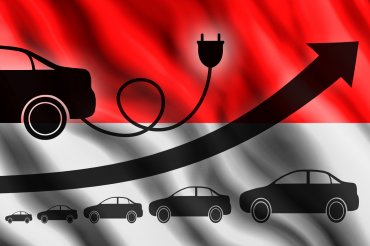Indonesia, the largest automotive market in Southeast Asia, is considering new fiscal policies and regulations to encourage production and purchases of electric vehicles. It would probably be years before EVs affect the lubricants market, though, because the penetration rate is currently low.
Minister of Industry Airlangga Hartarto said in a Feb. 14 news release that the country is preparing a roadmap to develop electric vehicle production andthat this can support our target in 2025 that 20 percent [of Indonesia’s vehicle fleet] be electric vehicles.

Photo: Pilotsevas/Shutterstock
Indonesia, the largest automotive market in Southeast Asia, is considering new fiscal policies and regulations to encourage production and purchases of electric vehicles.
In December 2018, [Indonesian President] Jokowi has stated that the electric vehicle regulation is still in the finalization progress and will be finalized and released in the beginning of 2019. We are convinced about that statement, given that the election month [in April] is coming up and Jokowi will ratify the regulation soon, said Gervasius Samosir, partner and managing director of Solidiance, a corporate strategy consulting firm in Indonesia that focuses on Asia.
A variety of fiscal schemes are under discussion, including eliminating the sales tax on EVs, reduction of import tariffs and offering tax cuts to EV battery producers and automakers.
Airlangga Hartarto has mentioned that electric vehicles, which produce lower carbon emissions, will eventually get a lower tax. Regarding the import tariffs for EVs, we think it will be completely reduced to zero percent for the next eight years – hence by then the automotive producers will be able to import the whole vehicle – referred to as complete built up or CBU – without any import tariff, Samosir told Lube Report.In July last year, the corporate strategy consultancy published a white paper, Electric Vehicles in Indonesia.
EVs require lubricants that are compatible with high electric currents present in their drive-trains. We suggest focusing on higher margin products such as synthetic lubes or high-grade lubes for the growing [hybrid electric vehicle] and [plug-in hybrid electric vehicle] markets, he said.
Opportunities for lubricants in the EV industry, however, exist only in HEV and PHEV segments, both having complex machinery specifications. [A battery electric vehicle] does not need engine lubricant, as they only operate with bearing and chassis grease, transmission fluid and gear oil, which together add up to a fraction of lubricant the lubricant volume demands of a conventional vehicle, he added.
Smaller lubricant blenders in Indonesia may lack the technical expertise to meet lubrication compatibility requirements for EVs but fake oils and low quality oils will not be phased out as long as there is no legislation to [enforce] their eradication; there has to be the necessary political will from the government to eradicate the distribution of these undesirable oils, and there must be the policing or the legal enforcement, an industry source, requesting anonymity, told Lube Report.
Indonesias target is to have 2.1 million electric motorcycles and 2,200 electric cars in 2025. The country currently has about 1,300 charging stations, 71 percent of which are located in Jakarta. With these facilities, Samosir said, Solidance believes that it will be much easier to fulfill the governments 2025 target for electric motorcycle penetration.
EVs in general are not a short-term thing, certainly not in the next five to 10 years here in Asia, maybe with the exception of China, and maybe Europe, said the industry source.
But in Indonesia it is still a long shot simply because of the non-existence of the appropriate ecosystem and the complex geographical nature of the Indonesian archipelago. EVs would probably start with small bikes meant for residential use, the source speculated.
Samosir concurs. With the current rate of adoption and unsolved issues in the market, it is unlikely that the target [for motor vehicles] would be achievable.
In 2017, Indonesias sales of passenger cars and other light- and heavy-duty vehicles reached 1 million units, representing one-third of the Association of Southeast Asian Nations market. Motorcycle sales totaled 6 million units, according to statistics released by the Asean Automotive Federation.